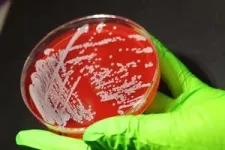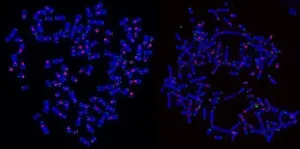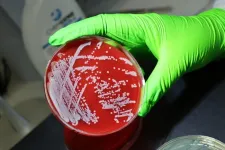(Press-News.org) This work reveals a new mechanism by which brown fat is converted into heat, and which protects from pathologies associated with obesity.
The MCJ protein is key to the fat burning mechanism now identified, making it a promising target for treating obesity, according to the authors in Nature Communications.
The research is led by Guadalupe Sabio, from Spain’s National Cancer Research Centre (CNIO), and Cintia Folgueira, from both CNIO and the National Centre for Cardiovascular Research (CNIC).
Obesity, which affects 650 million people worldwide, influences the development of cardiometabolic diseases and increases the risk of cancer. Guadalupe Sabio, head of the Organ Crosstalk in Metabolic Diseases Group at the National Cancer Research Centre (CNIO), and Cintia Folgueira, from CNIO and the National Centre for Cardiovascular Research (CNIC), have discovered one of the ways in which the body burns brown fat and converts it into heat. This mechanism protects against obesity and related metabolic diseases.
The mechanism now identified is controlled by the protein called MCJ, present in mitochondria (the organelles of the cell where energy is produced). Sabio and Folgueira have discovered that, when the MCJ protein is removed from obese mice, these animals produce more heat and lose weight. The researchers have also managed to reduce the weight of obese mice just by having them transplanted with fat without that protein.
Brown fat and obesity
Obesity is the result of either excessive food intake or inadequate total energy expenditure. We now know that adipose tissue –body fat–, in addition to storing energy, plays a crucial role in the management of that energy by the body. Adipose tissue is a complex organ that acts as a regulator of the whole body's metabolism, and therefore modulating its function could well be a way to combat obesity”, the authors write in Nature Communications.
There are two types of fatty or adipose tissue: white and brown. White adipose tissue mostly stores energy, while brown fat (its cells have more mitochondria and that gives them a brown hue) is responsible for heat generation or thermogenesis, the process that maintains body temperature and which is triggered by cold or other stimuli.
Several studies in the last decade have shown that activating brown fat protects against obesity and metabolic disease. “For some time,” explains Sabio, “it has been thought that obesity could be prevented by getting this fat to spend more energy by generating heat. So the first thing is to understand how it works.”
“Discovering new mechanisms of heat production in brown fat is one of the most interesting targets in the study of obesity,” says Sabio.
How to burn brown fat
For a long time it was thought that brown fat used a single mechanism to generate heat, but today we know that this is not the case. There are several mechanisms involved. The research led by Sabio and Folgueira has discovered one of them, controlled by a mitochondrial protein called MCJ.
The research conducted at CNIO has discovered that when the MCJ protein is removed from obese mice, these animals produce more heat and lose weight. Moreover, it was enough to transplant into the animals brown fat without the MCJ protein to reduce their weight.
Avoiding pathologies associated with obesity
The researchers also observed that “animals without MCJ in brown fat are protected against health problems caused by obesity, such as diabetes or increased blood lipids,” explain the two scientists. Therefore, they believe that the MCJ protein could be a new therapeutic target to correct diseases associated with obesity.
“This protection,” explains CNIO researcher Beatriz Cicuéndez, lead author of the article, “is due to the activation of an essential signalling pathway to adapt to the stress caused by obesity. Known as the catabolic pathway, it causes an increase in the consumption of fats, sugars and proteins to produce heat in brown fat. It is a mechanism that also happens in people with very active brown fat.”
Blocking the MCJ protein in obese patients
The research is now seeking to develop a therapy to block this protein in obese patients, but to do so they must first investigate whether the MCJ protein has vital functions in other tissues. At the same time, Guadalupe Sabio says, “we are trying to see if these changes in fat affect tumour growth or cachexia – loss of muscle and fat – which is also sometimes linked to cancer.”
END
CNIO and CNIC research identifies a key protein for ‘burning’ fat
This work reveals a new mechanism by which brown fat is converted into heat, and which protects from pathologies associated with obesity.
2025-01-13
ELSE PRESS RELEASES FROM THIS DATE:
‘True food’ research database offers rankings for 50,000 processed foods
2025-01-13
‘True Food’ Research Database Offers Rankings for 50,000 Processed Foods
The database, developed by researchers at Mass General Brigham and made available to the public, sheds light on the availability of processed foods at different grocery stores, highlighting the need for more understanding and regulation of the foods offered
A new study by investigators from Mass General Brigham provides information to empower consumers and policymakers about the degree of processing of the foods available at three large grocery retailers. Using an algorithm, the researchers analyzed ...
Mystery solved: how tumor cells die after radiotherapy
2025-01-13
Scientists at Children’s Medical Research Institute (CMRI) have solved a big mystery in cancer research – why cells die in different ways following radiotherapy. This surprising finding opens up new opportunities to improve treatment and increase cure rates.
The findings were published in Nature Cell Biology by first author Dr Radoslaw Szmyd of CMRI’s Genome Integrity Unit, which is led by Professor Tony Cesare.
Radiation therapy (also called radiotherapy) is a critically important type of cancer treatment. Scientists have struggled for decades to understand why radiation therapy kills cells from the ...
Bacterial survival genes uncovered using evolutionary map
2025-01-13
The most detailed study to date on the mechanisms by which a common type of bacterium, Staphylococcus aureus, adapts to living on the human body could help improve the prevention, diagnosis, and treatment of certain infections.
The study, from the Wellcome Sanger Institute, the University of Cambridge, the Institute of Biomedicine of Valencia (IBV) at the Spanish National Research Council (CSIC) and their collaborators, involved using the genomes of thousands of S. aureus isolates cultured from the human nose and on the skin to investigate which genes are important for the bacteria to adapt and persist.
Published today (13 January) in Nature Communications, ...
Sodium-ion batteries need breakthroughs to compete
2025-01-13
Legions of battery engineers and their supporters have sought for years to build batteries cheaper than the dominant lithium-ion technology, hoping to capture some of lithium-ion’s $50 billion-a-year and growing market. The latest darling contender among researchers, startups, and venture capitalists – sodium-ion batteries – has received much attention after COVID-induced mineral supply chain challenges sent lithium prices on a wild ride. Still, achieving a low-cost contender may be several years away for sodium-ion batteries and will require a set of technology advances and favorable ...
Tumor DNA in the blood can predict lung cancer outcome
2025-01-13
Scientists from the Francis Crick Institute, UCL, UCLH and Personalis have found that a test to detect circulating tumour DNA can predict lung cancer outcome in a Cancer Research UK-funded study.
Circulating tumour DNA (ctDNA) is fragments of DNA released into the blood by tumours. It’s known to be important for disease prognosis but can be difficult to measure precisely.
In research published today in Nature Medicine, Crick and UCL scientists worked with Personalis to test a platform called NeXT Personal, which can detect very small amounts – 1 part per million – ...
New study unveils breakthrough in understanding cosmic particle accelerators
2025-01-13
Scientists have come a step closer to understanding how collisionless shock waves – found throughout the universe – are able to accelerate particles to extreme speeds.
These shock waves are one of nature's most powerful particle accelerators and have long intrigued scientists for the role they play in producing cosmic rays – high-energy particles that travel across vast distances in space.
The research, published today in Nature Communications, combines satellite observations from NASA’s MMS (Magnetospheric Multiscale) and THEMIS/ARTEMIS missions with recent theoretical advancements, offering a comprehensive new model ...
Previous experience affects family planning decisions of people with hereditary dementia
2025-01-13
Living in a family where there is genetic risk for dementia significantly affects choices about having children and how to parent, finds a new study led by UCL researchers.
The research, published in the Journal of Genetic Counselling, interviewed 13 people – both parents and non-parents – who are at risk of developing familial frontotemporal dementia (fFTD).
This form of dementia often begins in mid-life and is characterised by behavioural and personality changes. Children of an affected parent are at 50% risk of inheriting the gene that causes the disease.
People in affected families fall into three groups: people who don’t choose to find out whether ...
Does obesity affect children’s likelihood of survival after being diagnosed with cancer?
2025-01-13
A recent population-based study indicates that among children with cancer, those with obesity at the time of diagnosis may face an elevated risk of dying. The findings are published by Wiley online in CANCER, a peer-reviewed journal of the American Cancer Society.
The retrospective study was based on information from the Cancer in Young People in Canada (CYP-C) database, including all children with newly diagnosed cancer aged 2 to 18 years across Canada from 2001 to 2020. Obesity was defined as age and sex-adjusted body mass index at or above the 95th percentile.
Among ...
Understanding bias and discrimination in AI: Why sociolinguistics holds the key to better Large Language Models and a fairer world
2025-01-13
The language ‘engines’ that power generative artificial intelligence (AI) are plagued by a wide range of issues that can hurt society, most notably through the spread of misinformation and discriminatory content, including racist and sexist stereotypes.
In large part these failings of popular AI systems, such as ChatGPT, are due to shortcomings with the language databases upon which they are trained.
To address these issues, researchers from the University of Birmingham have developed a novel framework for better understanding large language ...
Safe and energy-efficient quasi-solid battery for electric vehicles and devices
2025-01-13
Technological advances have led to the widespread use of electric devices and vehicles. These innovations are not only convenient but also environmentally friendly, offering an alternative to polluting fuel-driven machines. Lithium ion batteries (LIBs) are widely used in electrical appliances and vehicles. Commercial LIBs comprise an organic electrolyte solution, which is considered indispensable to make them energy efficient. However, ensuring safety becomes a concern and may be difficult to achieve with the rising market demand.
While solid-state batteries can help mitigate safety issues, the interface between solid electrodes and the ...
LAST 30 PRESS RELEASES:
Sophisticated neuroimaging reveals PTSD in WTC responders is linked to measurable physical changes in brain structure
Health policy experts identify promising strategies for providing health care to homeless people
Study explores role of neutrophils in canine atopic dermatitis
Mayo Clinic researchers develop AI-ECG model to diagnose liver disease earlier
Heavy menstruation common among teenage girls – questionnaire reveals risk of iron deficiency
New study explores why open water swimming feels so powerful for midlife women
In echo of Jurassic Park, mosquitoes capture entire ecosystems in their blood meals
Marty Cooper, Illinois Tech Alumnus and ‘Father of the Cell Phone,’ Receives 2025 Marconi Society Lifetime Achievement Award
How to reduce the risk of lymphedema
NEJM Evidence and CIDRAP announce Public Health Alerts
New fossil study illuminates on the evolutionary success of frogs
Patient-specific human liver model to understand disease mechanisms
Confused by the doctor's questionnaire? U of A study suggests it's common
How do brains stay stable, and when might a dose of flexibility be helpful?
mRNA revitalizes aging immune systems—the liver as a fountain of youth
Rural-urban differences in the prevalence of chronic pain among adult cancer survivors
Food insecurity, burnout, and social isolation among resident and fellow physicians
How do spinal cord injuries heal?
Detailed cell map unlocks secrets of how reproductive organs form
Large language models unleash AI’s potential for autonomous and explainable materials discovery
Gut bacteria have evolved rapidly to digest starches in ultra-processed foods
New risk score helps predict pancreatic cancer recurrence
New evidence challenges understanding of Parkinson’s disease
A new study reveals how embryos and the uterus “talk” during implantation
Cedars-Sinai reports heart attacks, general illness spiked after LA fires
PolyU develops ultra-stable, mucus-inspired hydrogel to boost gastrointestinal wound healing
Flour choice shapes sourdough microbial communities
Can a retinal implant reverse macular degeneration?
Feeding fungi plant remnants produces tasty protein to fortify vegan, vegetarian diets
New tech reduces false positives from breast ultrasounds
[Press-News.org] CNIO and CNIC research identifies a key protein for ‘burning’ fatThis work reveals a new mechanism by which brown fat is converted into heat, and which protects from pathologies associated with obesity.







